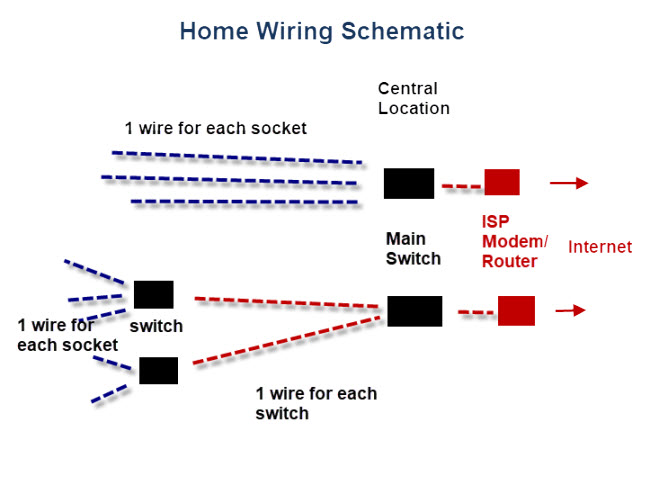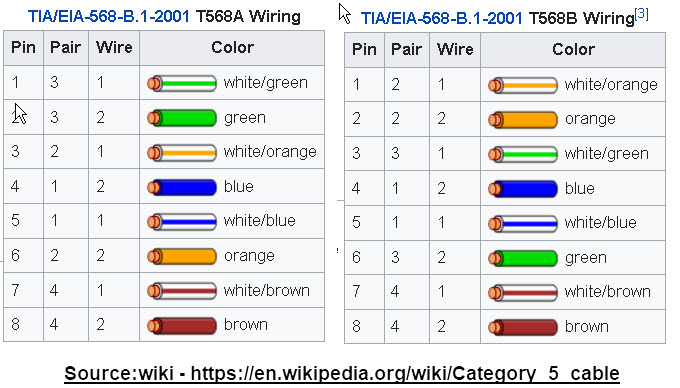Best Way to Run Network Cable in House
Although creating a wired Ethernet network isn't expensive information technology is time consuming, involves basic DIY abilities, and making a mess.
It is because of this that it is best washed when you have a completely new build or a major refurbishment.
At that place are many ways of extended your current network without drilling holes in walls and running Ethernet cables. See how to extend a dwelling house network.
Even so for those of you who are thinking of having it done ,or doing it yourself then I accept put together these inquiry notes that may help.
Getting Started
The starting time and most important role is creating a plan. You will need to consider:
- Will you lot take a Central distribution point? and Where will it be located.
- How many rooms will you wire?
- What are the Wiring routes?
- How many sockets in each room?
- Socket locations?
- Ethernet cable – Cat5, 6 or 7 Cablevision ? (cat vi recommended)
- Will you use a patch panel?
Next you demand to brand a list of what you will need.
- Basic Tools e.g. drills etc
- Networking tools for crimping cables.
- UTP Ethernet cablevision (Cat 5,half-dozen or 7)
- Termination sockets and connectors.
- Ethernet Switch or switches.
Ref: What are the requirements for a Home Network?
Networking Components Overview
Cable – For home networks true cat 6 is probably the best choice today. CAT seven (latest version) is shielded which adds complications to the installation.
Solid vs stranded cablevision – Meet hither. For backbone cabling use solid.
RJ45 Connectors -Terminates the cablevision and plugs into a computer/switch/socket.
Wall-socket –Terminates the cablevision in a room and accepts RJ45 Connectors.
Wall confront plates– These Cover wall sockets.
Keystone jacks These are female person connectors that are usually mounted into a wall plate or patch panel.They are part of a wall socket,
Keystone plug is the matching male connector, usually fastened to the end of a cable or string.
Mixing Cat5 cables, jacks and Cat 6 cables and Keystone Jacks. – The full general consensus it that it should work, simply effort not to exercise it. For example: Cat6 cable has a thicker copper wire and insulation and the cat6 jacks are made to take this into consideration.
Patch Panel and Wall Socket Types
Sometime type wall sockets and patch panels had the wiring connections as office of the socket/console whereas newer ones tend to have holes that accept keystone jacks. If you lookout man a couple of the videos you lot will come across these two types.
Home Ethernet Wiring Options
There
At that place are two main options as shown in the schematic above.
You can bring the cables from all wall sockets to a central location. This is the option shown in most home wiring videos on Youtube.
The other option is to apply several switches perhaps one per flooring and wire those switches dorsum to a central location.
This results in a potentially slower network, just it is the option chosen when cable routing isn't inside the wall.
What is in the Primal Location
This is where all of the cables from each of the room sockets come together, and plug into a switch.
Y'all have two selection for the cable ends:
- Wire into a patch panel ( about professional)
- Stop with RJ-45 plug.
Using a patch panel gives you more flexibility, but is probably an overkill in a pocket-size network.
Do you lot Need a Patch Panel?
The central location will most probably contain your Isp Router (Cable modem), but doesn't take to.
Notes:
Label cables at the cease in the central location every bit you need to know what room and socket they connect to.
Wiring Standards
This is what cable colour is wired to what pin on the connectors.
At that place are two wiring standards in utilize ( 568A or 568B –wiki ). You should cull one and use it consistently everywhere.
568A is more mutual in Europe and Pacific countries
568B is more than mutual in USA.

Estimated Costs Example
2 Storey business firm. iv rooms 2 sockets per room (8 double sockets total).
- Cablevision run length approx 12m to each socket
- 16 runs = 192m
- eight wall plates
- 16 keystone jacks
- switch minimum 16port but 24 port preferred.
- Patch Panel ii*24 port panels allows for expansion -Optional
- RJ45 Connectors
- Connector patch cables *16 or *32 (using patch panel)
If the wall plates take two terminations and then that ways double the cable and keystone jacks?
Cable 2*100m rolls £37 each= approx £74
Wall plates *8 at £iv each =£32
Keystone Jacks *16 at £8 per 8pack =£sixteen
connector cables *xvi at £8 per pack of five – £32
Sub Total = approx £154
Optional
Patch panel*2 (24port) at £22 each= £44
patch cables (0.3m) *16 at £8 per pack of five – £32
Total £230
Other extras that may be required:
Punch down and curling tools,cable ties, Drill bits etc
Useful video clips
Keystone Jack and Wall Plate
How to Wire a Wall Socket
The video shows a wall socket with the cable terminations on the back
Terminate CAT5 and Cat 6 cable using RJ45 connectors
Keystone Jack Wall Plate and Patch Console
Solid vs stranded Cable
Wiring a Patch Console
Wiring a Patch Console
This patch panel uses keystone Jacks
References
- Structure cabling- Home installation
- How to Wire Your House With Cat5 or 6
- Wiring a Home Network from the basis up
Related Tutorials
- Understanding Home Networking Speeds
- Setting Up a Home Router
- VLANS on Dwelling Networks
- Power Over Ethernet
Please Let me Know if yous found it Useful
Source: https://stevessmarthomeguide.com/wiring-home-network/
0 Response to "Best Way to Run Network Cable in House"
Post a Comment